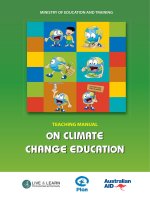Phương pháp phổ khối lượng (MS) trong phân tích cấu trúc hoá lý
Bạn đang xem bản rút gọn của tài liệu. Xem và tải ngay bản đầy đủ của tài liệu tại đây (927.48 KB, 51 trang )
PHỔ KHỐI LƯỢNG (MS)
NGUYÊN TẮC PHƯƠNG PHÁP MS
Đo khối lượng, không phải đo năng lượng
Phân tử được bắn phá bằng nguồn năng lượng lớn tạo thành
ion phân tử hay mảnh ion
Tỉ lệ khối lượng/điện tích (m/z) của tất cả các ion được ghi
nhận bằng cách thay đổi từ trường
Độ giàu tương đối của mỗi ion tương ứng với mỗi m/z được
thể hiện trong phổ MS
PHỔ KHỐI LƯỢNG
Khối lượng của ion phân tử cho biết khối lượng phân tử của
hợp chất
Khối lượng của các phân mảnh ion cho biết thông tin về cấu
trúc của hợp chất
PHỔ KHỐI LƯỢNG
Máy khối phổ có 3 bộ phận chính:
1. Buồng ion hóa: để hóa hơi và ion hóa các phân tử thành dịng
các hạt tích điện
2. Từ trường: làm chệch hướng dòng ion và tách chúng theo giá
trị m/z
3. Detector: phát hiện và đếm các ion đã tách, tín hiệu điện thu
được tỉ lệ với lượng ion ghi nhận
MÁY KHỐI PHỔ
MÁY KHỐI PHỔ
CÁC PHƯƠNG PHÁP ION HĨA MẪU
Mẫu có thể được ion hóa bằng các phương pháp:
Electron impact (EI)
Chemical ionization (CI)
Atmospheric pressure ionization (API)
Atmospheric pressure chemical ionization (APCI)
Electrospray ionization (ESI)
KHỐI PHỔ BY
ELECTRON IMPACT (EI)
Electron bombardement
( 70 eV)
Fragmentation
Deep vacuum
(10-4 N/m2)
Unknown molecule
with a lone pair of
electron
Molecular ion,
radical cation
Charged,
detectable
Charged,
detectable
Uncharged,
Non detectable
Limitations:
Fast fragmentation of unstable molecules
risk of loss of molecular peak
Molecular ions (radical cations) are unstable
decompose before reaching the detector (during 20 s)
MASS SPECTROMETRY BY
ELECTRON IMPACT (EI) – EXAMPLE
MASS SPECTROMETRY BY
CHEMICAL IONIZATION (CI)
Reagent gas
CnH2n+2
[CnH2n+1]
Formation of [M+H] or [M-H]
cations
H2
, more stable than radical
MASS SPECTROMETRY BY
CHEMICAL IONIZATION (CI) – EXAMPLE
(i) EI
(ii) CI
Mass spectrum of proline (i) by electron impact (ii) by chemical ionization
MASS SPECTROMETRY BY
CHEMICAL IONIZATION (CI)
Useful technique when no molecular ion is observed by EI
Confirmation of the presence of molecular ion when the signal
by EI is too weak
Common reagent gases are methane, ammonia and isobutane
There are 2 modes of chemical ionization
Positive ion chemical ionization (PICI)
Negative ion chemical ionization (NICI)
POSITIVE ION CHEMICAL IONIZATION (PICI)
[GH]
+
M
[MH]
+
G
Methane:
Relevant molecular peaks observed are MH+, [M+CH5]+ and
[M+C2H5]+, mainly MH+
POSITIVE ION CHEMICAL IONIZATION (PICI)
Ammonia:
Relevant molecular peaks observed are MH+, [M+NH4]+
Isobutane:
Relevant molecular peaks observed are MH+
POSITIVE ION CHEMICAL IONIZATION (PICI) –
CHOICE OF REAGENT GAS
[GH]
+
M
[MH]
+
G
These proton transfer reactions are true protonation reactions
by Bronsted acid in the gas phase
Factors determine the choice of the gas to be used
Proton affinity (PA): PAM > PAG
Energy transfer, e.g. NH4+ has low energy transfer than CH5+
Reactivity of reagent gas toward the sample
Choice of reagent gas affect the extend of fragmentation of the
quasi-molecular ion
POSITIVE ION CHEMICAL IONIZATION (PICI) –
EXAMPLES
Comparison of (a) 70 eV EI spectrum and (b) methane reagent gas CI spectrum of the
amino acid methionine
POSITIVE ION CHEMICAL IONIZATION (PICI) –
EXAMPLES
Isobutane CI mass spectrum of gastric content in an overdose case
Milne et al. Anal. Chem. 1970, 42, 1815
NEGATIVE ION CHEMICAL IONIZATION (NICI)
M +
e
M
0-2 eV
M +
e
[M-A]
+
A
0-15 eV
Electrons are thermalized in a high pressure source by a
reagent gas, e.g. methane
Compounds with electrophilic moieties (halogen, nitro group)
capture the thermal electrons producing abundant negative ions,
typically the molecular anion
NICI is highly selective & sensitive (like ECD)
Molecular ions observed are usually M or [MH]
NEGATIVE ION CHEMICAL IONIZATION (NICI) –
EXAMPLE
EC spectrum of benzo[a]pyrene, isobutane buffer gas, ion source 200C
ADVANTAGES OF CHEMICAL IONIZATION
Positive ion chemical ionization:
Molecular weight can be obtained and confirmed
Increased sensitivity & selectivity for many compounds
Selectivity can be affected by choosing appropriate reagent gas
CI spectra are complemetary to EI spectra
Negative ion chemical ionization:
Highly sensitive & selective ionization technique (NICI > PICI >
EI), ideal for analysis of analytes in complex matrices
Molecular weight can be obtained and comfirmed
Also complementary to PICI & EI spectra
ATMOSPHERIC PRESSURE IONIZATION (API)
Mostly used in HPLC/MS
There are two API techniques
Atmospheric pressure chemical ionization (APCI)
Electrospray ionization (ESI)
MS/MS API-365
ATMOSPHERIC PRESSURE CHEMICAL
IONIZATION (APCI)
Mechanism for positive ion formation:
Primary ion formation
Secondary ion formation
Analyte ion formation
H3O
+
M
[M+H]
+ H2O
APCI PROCESS IN THE POSITIVE ION
POLARITY MODE
ESI PROCESS IN THE POSITIVE ION
POLARITY MODE
CHOICE OF APCI OR ESI
Both APCI & ESI can be used for analysis of medium to quite
high polar compounds and may give different sensitivity
APCI
ESI
Analyte has low molecular mass
Analyte has high molecular mass
(commonly biological molecules)
Analyte has medium polarity
Analyte has high polarity
Analyte has low thermal stability
Softer ionization
fragmentation)
technique
(less









